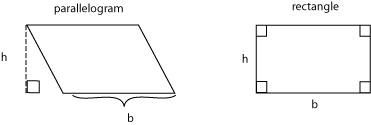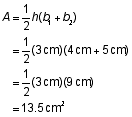 username@email.com
username@email.com
In the upcoming section, we’ll review a variety of formulas to measure the perimeter and area of quadrilaterals.
Recall that the perimeter of a polygon is the sum of the lengths of its sides. Questions involving the perimeter of a parallelogram may rely on your knowledge of the properties of that parallelogram. Let’s look at some examples.
Which of the following gives the perimeter of a rhombus with side length s?
Choice C is the correct answer. The perimeter of a polygon is the sum of the lengths of its sides. Since all four sides of a rhombus are congruent, the perimeter is s + s + s + s, or 4s. In fact, you could have eliminated all of the other choices, since they give measures in square units.
Which of the following gives the perimeter of a rectangle with length l and width w?
Choice C is the correct answer. Since the opposite sides of a rectangle are congruent, they have the same measure. So the perimeter of a rectangle is equal to the sum of 2 lengths (2l) and 2 widths (2w): 2l + 2w = 2(l + w).
Parallelograms: The area of a parallelogram is given by the formula A = bh, where b is the base and h is the height. Again, be careful. Don’t forget that the base and the height must be perpendicular.

 ?
?
What is the area of this parallelogram?

Choice B is correct. The area of a parallelogram is , where b is the base and h is the height. The base of this parallelogram is 4 cm long. Because the height must be perpendicular to the base, the height is 2 cm. If you answered A, you may have used the formula for the area of a triangle rather than the area of a parallelogram. If you answered D, you may have been finding the perimeter rather than the area. So the area is:

The area of a trapezoid is given by the formula  , where h is the height and b1 and b2 are the lengths of the parallel bases.
, where h is the height and b1 and b2 are the lengths of the parallel bases.

What is the area of the trapezoid below? Round your answer to the nearest tenth of a square centimeter.

Choice B is the correct answer. The area of the trapezoid is given by the formula  , where h = 3 cm, b1 = 4 cm, and b2 = 5 cm. So the area of the trapezoid is:
, where h = 3 cm, b1 = 4 cm, and b2 = 5 cm. So the area of the trapezoid is:

 , where h is the height and b1 and b2 are the lengths of the parallel bases.
, where h is the height and b1 and b2 are the lengths of the parallel bases.